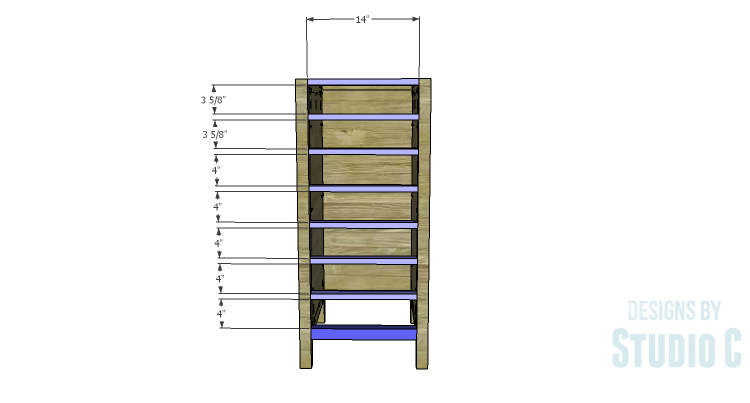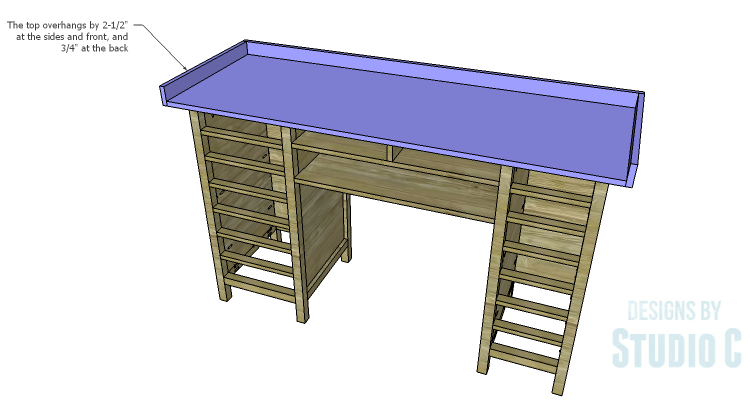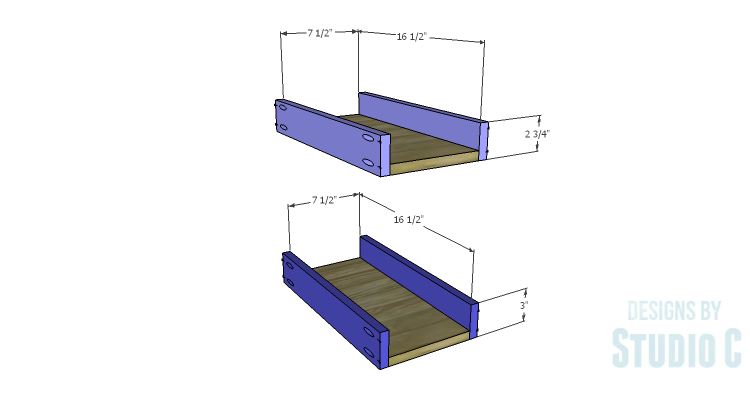DIY Plans to Build a Jeweler’s Desk
The Perfect Desk for a Jewelry Maker
Let me start off with a warning for these plans: this jewelry making desk has a lot of drawers. Eighteen of them, to be exact and the plans will require eighteen sets of ball-bearing drawer slides (eBay is a great source for a deal on drawer slides!). Don’t let the number of drawers deter you from these fabulous plans! The DIY plans to build a Jeweler’s Desk feature seven drawers on each side (one set is wider than the other), two center drawers, and two wide and flat center drawers. The top has a lip around the edge, and the desk is quite tall making it easier to work while standing!

Materials:
- 1-1/4″ pocket hole screws (<– affiliate link!)
- 2-1/2″ pocket hole screws
- Edge banding, optional
- 18 sets of 18″ drawer slides
- Cabinet pulls
- Wood glue
- Sandpaper (100, 150, 220 grits)
- Finishing supplies (primer & paint, or stain, sealer)
Lumber:
- 3 – 1×2 at 8′
- 1 – 1×4 at 4′
- 1 – 1×4 at 6′
- 6 – 2×2 at 8′
- 3 – 4′ x 8′ sheets of 3/4″ plywood
Cut List:
- 8 – 2×2 at 38″ – Legs
- 8 – 2×2 at 17″ – Side Framing
- 4 – 3/4″ plywood at 17″ x 31″ – Side Panels
- 8 – 1×2 at 14″ – Wider Drawer Stretchers
- 2 – 2×2 at 14″ – Wider Drawer Stretchers
- 1 – 3/4″ plywood at 14″ x 31-3/4″ – Wider Drawer Back Panel
- 8 – 1×2 at 10″ – Narrower Drawer Stretchers
- 2 – 2×2 at 10″ – Narrower Drawer Stretchers
- 1 – 3/4″ plywood at 10″ x 31-3/4″” – Narrower Drawer Back Panel
- 1 – 3/4″ plywood at 9-1/2″ x 30″ – Center Back
- 1 – 1×2 at 30″ – Center Stretcher
- 1 – 3/4″ plywood at 3-3/4″ x 19-1/4″ – Center Drawer Divider
- 1 – 3/4″ plywood at 19-1/4″ x 31-1/2″ – Upper Center Shelf
- 1 – 3/4″ plywood at 20″ x 31-1/2″ – Lower Center Shelf
- 2 – 1×2 at 17″ – Upper Center Drawer Slide Spacers
- 2 – 3/4″ plywood at 6″ x 17″ – Lower Center Drawer Slide Spacers
- 1 – 3/4″ plywood at 22-1/2″ x 63-1/2″ – Top
- 2 – 1×4 at 22-1/2″ – Top Side Lip
- 1 – 1×4 at 65″ – Top Back Lip
- 2 – 3/4″ plywood at 12-1/8″ x 16-1/2″ – Upper Center Drawer Box Bottom
- 2 – 3/4″ plywood at 16-1/2″ x 27-1/2″ – Lower Center Drawer Box Bottom
- 4 – 3/4″ plywood at 2-1/4″ x 16-1/2″ – Upper Center Drawer Box Sides
- 4 – 3/4″ plywood at 2″ x 16-1/2″ – Lower Center Drawer Box Sides
- 4 – 3/4″ plywood at 2-1/4″ x 13-5/8″ – Upper Center Drawer Box Front & Back
- 2 – 3/4″ plywood at 2″ x 29″ – Lower Center Drawer Box Back
- 2 – 3/4″ plywood at 2-3/4″ x 14-3/8″ – Upper Center Drawer Fronts
- 2 – 3/4″ plywood at 2-1/4″ x 29-3/4″ – Lower Center Drawer Fronts
- 7 – 3/4″ plywood at 7-1/2″ x 16-1/2″ – Narrow Drawer Box Bottom
- 10 – 3/4″ plywood at 3″ x 16-1/2″ – Narrow Drawer Box Sides (Lower)
- 4 – 3/4″ plywood at 2-3/4″ x 16-1/2″ – Narrower Drawer Box Sides (Upper)
- 10 – 3/4″ plywood at 3″ x 9″ – Narrower Drawer Box Front & Back (Lower)
- 4 – 3/4″ plywood at 2-3/4″ x 9″ – Narrower Drawer Box Front & Back (Upper)
- 5 – 3/4″ plywood at 3-3/4″ x 9-1/4″ – Narrower Drawer Fronts (Lower)
- 2 – 3/4″ plywood at 3-3/8″ x 9-1/4″ – Narrower Drawer Fronts (Upper)
- 7 – 3/4″ plywood at 11-1/2″ x 16-1/2″ – Wider Drawer Box Bottom
- 10 – 3/4″ plywood at 3″ x 16-1/2″ – Wider Drawer Box Sides (Lower)
- 4 – 3/4″ plywood at at 2-3/4″ x 16-1/2″ – Wider Drawer Box Sides (Upper)
- 10 – 3/4″ plywood at 3″ x 13″ – Wider Drawer Box Front & Back (Lower)
- 4 – 3/4″ plywood at 2-3/4″ x 13″ – Wider Drawer Box Front & Back (Upper)
- 5 – 3/4″ plywood at 3-3/4″ x 13-3/4″ – Wider Drawer Fronts (Lower)
- 2 – 3/4″ plywood at 3-3/8″ x 13-3/4″ – Wider Drawer Fronts (Upper)

Step One
Edge banding will be applied to the exposed edges of the plywood prior to assembly.
Cut the pieces for the legs, the side framing, and the side panels. With the pocket hole jig set for 1-1/2″ material, drill pocket holes in each end of the 2×2 framing pieces. Secure the 2×2 pieces to the legs using glue and 2-1/2″ pocket hole screws.
Drill pocket holes in all four edges of the panels. Secure the panel to the legs and framing pieces using glue and 1-1/4″ pocket hole screws. The inside face of the panels will be flush with the inside faces of the framing and legs.

Step Two
Cut the pieces for the upper stretchers, lower stretchers, the center legs, and the back for both the wider drawer cabinet and the narrow drawer cabinet. Set the pocket hole jig for 1-1/2″ material and drill pocket holes in each end of the 2×2 lower stretchers. Secure the 2×2 pieces to the legs using glue and 2-1/2″ pocket hole screws. When securing the pieces to the side panels, a close quarter drill or right angle drill attachment may be needed.
Set the pocket hole jig for 3/4″ material and drill pocket holes in each end of the 1×2 stretchers. Secure the one of the 1×2 pieces to the legs using glue and 1-1/4″ pocket hole screws. Orient the pocket holes so they face up and will be hidden by the top.
Drill pocket holes in all four edges of the back panel. Secure the panel to the legs and framing pieces using glue and 1-1/4″ pocket hole screws. The inside face of the panels will be flush with the inside faces of the framing and legs.


Step Three
Secure the front stretchers to the legs using glue and 1-1/4″ pocket hole screws (for the 1x2s) and 2-1/2″ pocket hole screws (for the 2x2s). The pocket holes on the uppermost stretcher will face up and be hidden by the top while the pocket holes for the remaining pieces will face down.


Step Four
Cut the piece for the back. Drill pocket holes in the side edges as well as one long edge for the bottom. Secure the sides to the legs using glue and 1-1/4″ pocket hole screws. The back face (with the pocket holes) will be flush with the outside face of the legs.
Drill pocket holes in each end of the center front stretcher. Secure the stretcher to the legs using glue and 1-1/4″ pocket hole screws orienting the pocket holes so they face up and will be hidden by the top.

Step Five
Cut the pieces for the upper shelf and divider, cutting the notches with a jigsaw. Drill pocket holes in the side and back edges of the shelf (these are not shown in the drawing). Secure the divider to the top face of the shelf using glue and 1-1/4″ brad nails through the bottom of the shelf into the divider.
Position the shelf and divider as shown, securing in place using glue and 1-1/4″ pocket hole screws. Add a few brad nails through the back and through the front stretcher into the divider.



Step Six
Cut the piece for the lower center shelf. Drill pocket holes in the side and back edges of the shelf (these are not shown in the drawing). Position the shelf as shown (the shelf will fit under the back piece), securing in place using glue and 1-1/4″ pocket hole screws. Add a few pocket hole screws through the back into the back edge of the lower shelf.

Step Seven
Cut the pieces for the drawer slide spacers. Secure the spacers to the middle leg panels (on each side of the center shelves) as shown using glue and 1-1/4″ brad nails.

Step Eight
Cut the pieces for the top and the top trim. Secure the side trim to the top first, using glue and 1-1/4″ brad nails, then secure the back trim. The top will overhang the cabinet by 2-1/2″ at the sides and front, and 3/4″ at the back. Secure in place using glue and 1-1/4″ brad nails.


Step Nine
Cut the pieces for the center drawer boxes. The two flat center drawer boxes are assembled a bit differently than the remaining drawers. Starting with the upper center drawer boxes, drill pocket holes in each end of the pieces for the sides as well as all four edges of the bottoms. Assemble the drawer boxes by securing the sides to the bottom using glue and 1-1/4″ pocket hole screws, then secure the front and the back with glue and 1-1/4″ pocket hole screws.
For the lower center drawer boxes, drill pocket holes in one end of the side pieces, as well as the sides and back edge of the drawer bottom. (It will be a three-sided drawer box.) Secure the sides using glue and 1-1/4″ pocket hole screws, then secure the back with glue and 1-1/4″ pocket hole screws.
Install the drawer slides for the upper center drawer boxes, locating them 3/4″ back from the front face of the legs.
Install the drawer slides for the lower center drawer boxes, locating them 3/4″ back from the front face of the legs. The drawer slides for these drawer boxes will be located 2-3/8″ down from the back face of the upper shelf and 1/8″ above the top face of the lower shelf.


Step Ten
Cut the pieces for the drawer boxes. Drill pocket holes in all four edges of the bottom as well as each end of the sides. Assemble the drawer boxes as shown using glue and 1-1/4” pocket hole screws. Install the drawer slides according to the manufacturer’s installation instructions, locating them ¾” back from the front edge of the legs. Check out this easy tutorial on installing drawer slides. Make any necessary adjustments.


Step Eleven
Cut the pieces for the drawer fronts except for the lower center drawer fronts. Mark the position for the drawer pulls and drill the holes. Shim the drawer front in the opening – there will be a 1/8” gap around all sides – then drive screws through the holes for the drawer pulls into the drawer box. Open the drawer, and secure the drawer front using countersunk 1-1/4” screws from the inside. Remove the screws from the holes for the drawer pull then finish drilling the holes. Take a look at this easy tutorial on installing drawer fronts.
For the lower center drawer fronts, There will be a 1/8″ gap at the sides and top or bottom, as well as a 1/4″ gap between the drawer fronts. Position the lower drawer front on the lower shelf over the three-sided drawer box, and secure to the drawer box using glue and 1-1/4″ brad nails through the drawer front into the side and bottom edges of the drawer box.
Position the remaining drawer front, securing in place with glue and 1-1/4″ brad nails through the drawer front into the side and bottom edges of the drawer box.


Finish as desired, then install the drawer pulls.
This desk is also a great option as an artist’s table, or as a craft station! This is a simple build and can be completed in a weekend, especially if the drawer boxes are tag-teamed! Have any questions about the DIY plans to build a Jeweler’s Desk? Leave a comment below!
Originally posted 2015-01-28 08:00:44.

